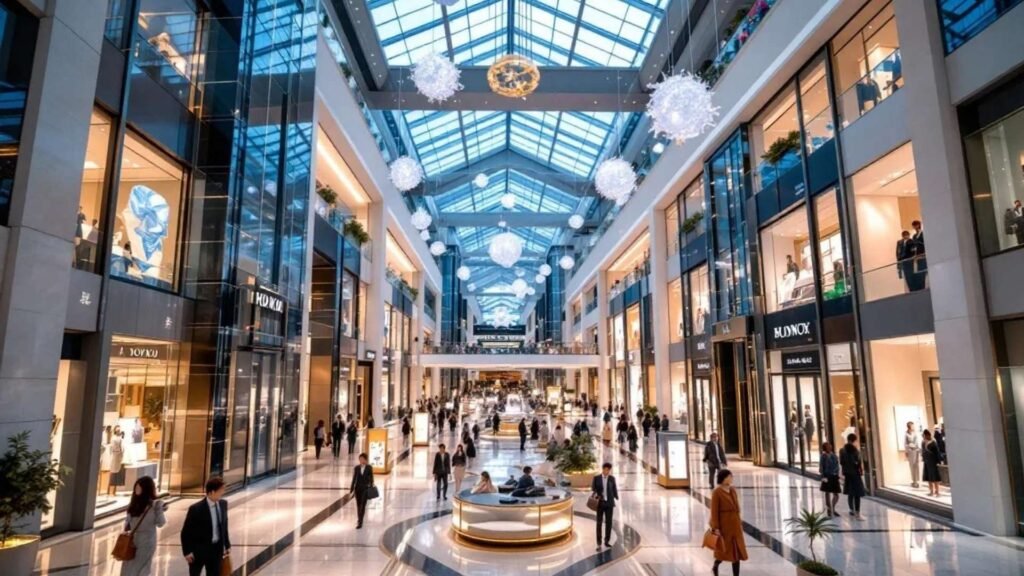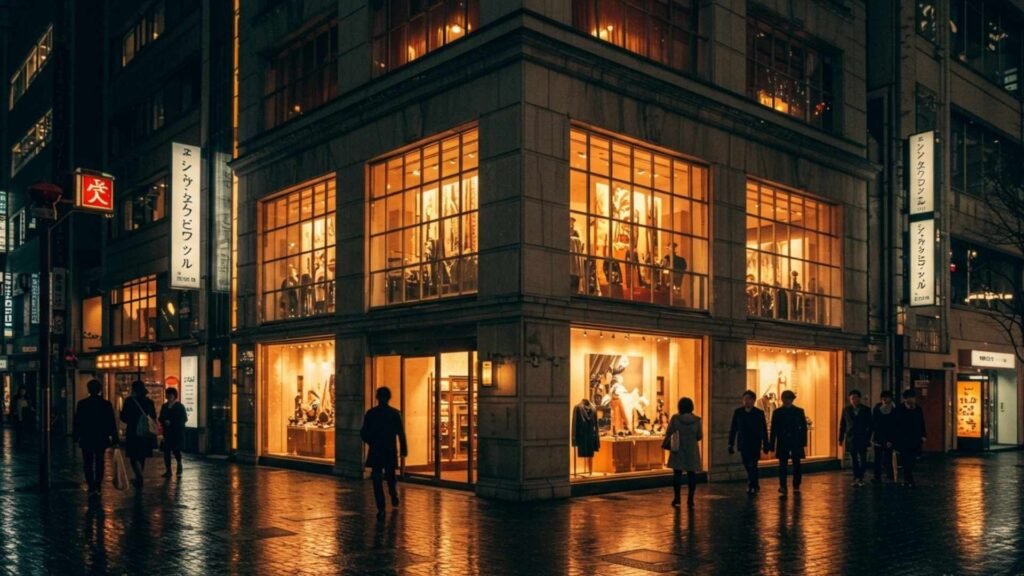Located in the very heart of Tokyo, Ginza is considered not only Japan’s but also one of Asia’s most prestigious fashion and shopping districts. Here, a luxury retail tradition spanning over a century blends seamlessly with the glitter of modern skyscrapers and the innovation of cutting-edge window displays. Every corner of this neighborhood tells a different story, and its energy remains vibrant from the first light of morning until late into the night. Ginza is the tangible reflection of Japan’s refined and sophisticated lifestyle, while also serving as the most spectacular stage for global luxury brands and contemporary design in Tokyo.
In Ginza, modern architecture and traditional Japanese aesthetics coexist in perfect harmony. Glass-fronted boutiques rise alongside buildings with traditional wooden shutters, while the golden glow of street lamps reflects on the polished sidewalks of Chuo-dori Street. Here, shopping is not merely the act of purchasing goods — it is an experience, a way of life. For this reason, Ginza holds a place on the must-visit list of every traveler, from fashion enthusiasts and art collectors to gourmet seekers and photography lovers.
1. The Fashion Atmosphere of Ginza
Ginza is Tokyo’s haute couture runway. Walking down its wide, polished sidewalks feels like stepping into a living fashion magazine. Every storefront is a work of art, with windows carefully curated to showcase not just products but brand identities and visions.
- Global powerhouses: Louis Vuitton’s shimmering glass façade, Chanel’s monochrome elegance, Dior’s seasonally inspired displays — each store offers a multi-sensory experience.
- The spirit of Japanese design: Issey Miyake’s groundbreaking fabric innovations, Comme des Garçons’ avant-garde creations, and Yohji Yamamoto’s minimalist yet striking silhouettes stand as a testament to Japan’s creative edge.
- Street style showcase: From impeccably tailored business suits to women carrying unique, handcrafted handbags, Ginza’s pedestrians contribute to its living gallery of style.
2. Shopping Landmarks and Must-Visit Spots

Shopping in Ginza isn’t just about entering stores — each building, floor, and display tells its own story.
- Ginza Six: Home to over 240 brands, with soaring ceilings, wide walkways, a rooftop terrace with panoramic city views, and art installations integrated into the shopping experience.
- Mitsukoshi & Matsuya Ginza: Historic department stores combining Japanese omotenashi hospitality with modern luxury. Don’t miss their depachika food halls for artisanal sweets, fresh seafood, and gourmet treats.
- Uniqlo Ginza: A 12-floor fashion temple showcasing the best of Japanese minimalist design and interactive shopping concepts.
- Itoya: Over a century old, this stationery paradise offers handcrafted paper, calligraphy brushes, and artist-grade notebooks.
3. The Balance of Luxury and Everyday Fashion

One of Ginza’s most captivating traits is its perfect harmony between haute couture and accessible fashion.
- High fashion: Couture collections, bespoke tailoring services, and limited-edition pieces exclusive to Ginza.
- Accessible brands: Zara, H&M, and Muji stand alongside flagship luxury stores, giving the district diversity.
- Hidden gems: Small Japanese boutiques offering minimalist designs, handmade accessories, and streetwear-inspired collections.
Here, you can easily mix a designer handbag with an affordable yet stylish dress to create your own Tokyo-inspired look.
4. Beyond Fashion – Experiencing Ginza
Ginza offers far more than just retail therapy; it is a lifestyle destination rich in culture, art, and gastronomy.
- Art galleries: Shiseido Gallery showcases contemporary Japanese art, while Ginza Graphic Gallery celebrates innovative typography and graphic design.
- Tea houses: Traditional tatami rooms where matcha and delicate wagashi sweets provide a peaceful pause in the day.
- Gastronomy: From the world-famous Michelin-starred sushi of Sukiyabashi Jiro to elegant French fine dining and cozy ramen bars, Ginza’s culinary scene is as refined as its fashion.
5. Best Times to Visit
Ginza’s atmosphere changes with the seasons, offering something special all year round.
- Weekends: Chuo-dori Street closes to traffic, turning into a wide pedestrian promenade perfect for window shopping and photography.
- Holiday season: Storefront decorations and festive lighting transform the district into an open-air art installation.
- Cherry blossom season: In spring, pastel blossoms complement the refined store displays, adding a romantic touch to the streetscape.
6. Ginza After Dark
When the sun sets, Ginza enters a new rhythm.
- Neon glow: Colorful reflections ripple across glass façades, creating a cinematic Tokyo night scene.
- Late-night shopping: Some stores remain open until late, offering a calmer and more intimate shopping experience.
- Photography moments: After a light rain, reflections on the pavement create dramatic, mirror-like surfaces — perfect for night photography.
Final Thoughts
Ginza is more than just a shopping district — it’s a living showcase of Japan’s refined spirit intertwined with the innovation of global fashion. Spending a day here is not simply about buying clothes; it’s about immersing yourself in an atmosphere where art, culture, food, and impeccable service come together. Every step you take along its glistening streets becomes part of a memory, lit by the glow of shop windows and the hum of Tokyo’s heartbeat. For anyone visiting Tokyo, Ginza is a destination that blends elegance and energy in a way you’ll never forget.

